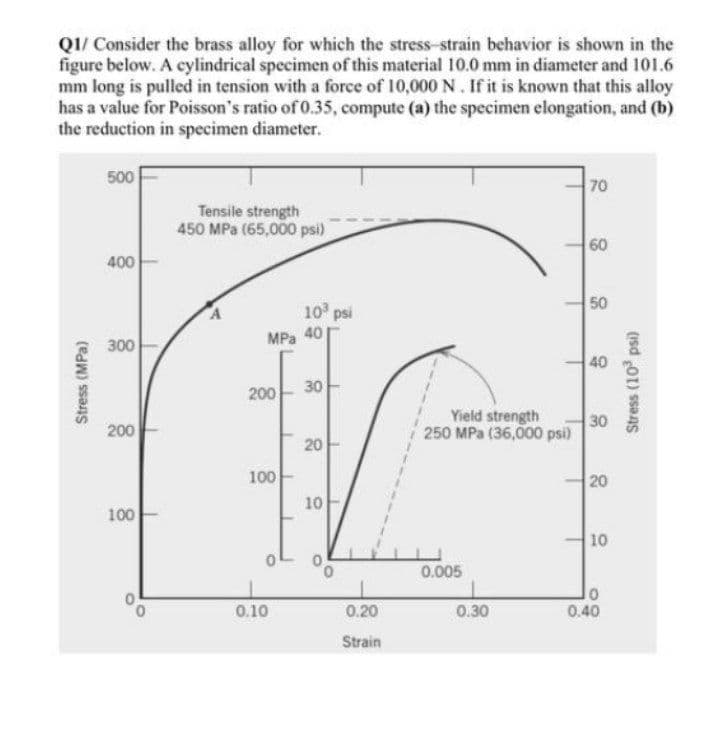QI/ Consider the brass alloy for which the stress-strain behavior is shown in the figure below. A cylindrical specimen of this material 10.0 mm in diameter and 101.6 mm long is pulled in tension with a force of 10,000 N. If it is known that this alloy has a value for Poisson's ratio of 0.35, compute (a) the specimen elongation, and (b) the reduction in specimen diameter.
QI/ Consider the brass alloy for which the stress-strain behavior is shown in the figure below. A cylindrical specimen of this material 10.0 mm in diameter and 101.6 mm long is pulled in tension with a force of 10,000 N. If it is known that this alloy has a value for Poisson's ratio of 0.35, compute (a) the specimen elongation, and (b) the reduction in specimen diameter.
Introduction to Chemical Engineering Thermodynamics
8th Edition
ISBN:9781259696527
Author:J.M. Smith Termodinamica en ingenieria quimica, Hendrick C Van Ness, Michael Abbott, Mark Swihart
Publisher:J.M. Smith Termodinamica en ingenieria quimica, Hendrick C Van Ness, Michael Abbott, Mark Swihart
Chapter1: Introduction
Section: Chapter Questions
Problem 1.1P
Related questions
Question

Transcribed Image Text:QI/ Consider the brass alloy for which the stress-strain behavior is shown in the
figure below. A cylindrical specimen of this material 10.0 mm in diameter and 101.6
mm long is pulled in tension with a force of 10,000N. If it is known that this alloy
has a value for Poisson's ratio of 0.35, compute (a) the specimen elongation, and (b)
the reduction in specimen diameter.
500
70
Tensile strength
450 MPa (65,000 psi)
60
400
50
10 psi
40
MPa
300
40
30
200
Yield strength
30
200
250 MPa (36,000 psi)
20
100
20
10
100
10
0.005
0.10
0.20
0.30
0.40
Strain
Stress (MPa)
20
Stress (10 psi)
Expert Solution
This question has been solved!
Explore an expertly crafted, step-by-step solution for a thorough understanding of key concepts.
This is a popular solution!
Trending now
This is a popular solution!
Step by step
Solved in 2 steps

Knowledge Booster
Learn more about
Need a deep-dive on the concept behind this application? Look no further. Learn more about this topic, chemical-engineering and related others by exploring similar questions and additional content below.Recommended textbooks for you

Introduction to Chemical Engineering Thermodynami…
Chemical Engineering
ISBN:
9781259696527
Author:
J.M. Smith Termodinamica en ingenieria quimica, Hendrick C Van Ness, Michael Abbott, Mark Swihart
Publisher:
McGraw-Hill Education

Elementary Principles of Chemical Processes, Bind…
Chemical Engineering
ISBN:
9781118431221
Author:
Richard M. Felder, Ronald W. Rousseau, Lisa G. Bullard
Publisher:
WILEY

Elements of Chemical Reaction Engineering (5th Ed…
Chemical Engineering
ISBN:
9780133887518
Author:
H. Scott Fogler
Publisher:
Prentice Hall

Introduction to Chemical Engineering Thermodynami…
Chemical Engineering
ISBN:
9781259696527
Author:
J.M. Smith Termodinamica en ingenieria quimica, Hendrick C Van Ness, Michael Abbott, Mark Swihart
Publisher:
McGraw-Hill Education

Elementary Principles of Chemical Processes, Bind…
Chemical Engineering
ISBN:
9781118431221
Author:
Richard M. Felder, Ronald W. Rousseau, Lisa G. Bullard
Publisher:
WILEY

Elements of Chemical Reaction Engineering (5th Ed…
Chemical Engineering
ISBN:
9780133887518
Author:
H. Scott Fogler
Publisher:
Prentice Hall


Industrial Plastics: Theory and Applications
Chemical Engineering
ISBN:
9781285061238
Author:
Lokensgard, Erik
Publisher:
Delmar Cengage Learning

Unit Operations of Chemical Engineering
Chemical Engineering
ISBN:
9780072848236
Author:
Warren McCabe, Julian C. Smith, Peter Harriott
Publisher:
McGraw-Hill Companies, The